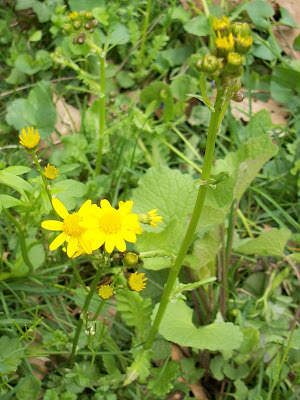If you are not familiar with alien invasives, they are plants (and animals) that have been introduced into a new country that out-compete native plants (and animals). This is mainly a problem, because native plants have thousands of relationships with other organisms, particularly insects and fungi, and alien invasives have very few. Consider the oaks (Genus Quercus). According to Douglas Tallamy's research, oak trees support around 534 species of butterflies and moths (Lepidoptera) alone. And these are just the leaf munching caterpillars. This doesn't include the sap-sucking true bugs (Hemiptera) or the insect world's most diverse group, the beetles (Coleoptera). My good friend Kathleen and I tried to spread this message at last year's Bugstock at Glen Helen. Here's a picture taken by Kathleen of me leading a hike with Glen Helen naturalists Margaret and Peter and local wild edibles guru, Dave Jansen.
Because insects (and fungi) are an important food source for other organisms like birds, mice, turtles and on up the food chain, alien invasive plants limit the amount of food available for many other creatures. So caterpillars are a big deal. There are literally thousands of different species of Lepidoptera. Many of them are small and incospicuous and their caterpillars feed high in the canopy of the forest, out of sight.
Amur Honeysuckle, however, if left to grow rampant, will form dense thickets in which little but its own kind will grow and very few caterpillars thrive.
Here is our pro-caterpillar work site. The green shrubs at the eye level are Amur Honeysuckle and part of a thicket that formed when the farmland around our old century house was left fallow some 60 years ago. We removed much honeysuckle from around these wooden posts and some more in the back that were encroaching on our back yard.
In the process of removing these shrubs, I discovered a few saplings colonizing in the same area: Green Ash, Sugar Maple, Bitternut Hickory, Black Cherry and Box Elder. These young trees could not stay under the clothesline, but they could go in the back end of the yard.
Instead of tossing these native hardwoods out with the rest of the weeds, I replanted them in an area that was recently cleared of honeysuckle. It feels good doing something that you know will have a long lasting effect. As these trees mature in the open sun they will produce additional shade which discourages the germination of honeysuckle seeds.
Planting these trees will help bring back an abundance of insects and
birds, and with the birds will hopefully be dispersed seeds from other
native trees, shrubs and wildflowers. Here is a picture of yellow trout lilies (Erythronium americanum), a perfect mascot for the deciduous forests of eastern North America. Click the picture to learn more about the amazing relationships this plant has with other living things.
Instead of throwing the honeysuckle to the curb or burning it, we built a brush pile to provide shelter for birds, rabbits, mice and other wildlife. As these branches begin to decompose, lichens and fungi well help to return their nutrients to the local environment. We also moved the rotten log to which the clothesline used to be attached to provide lodging for beetles, frogs, salamanders and the occasional box turtle.
After a couple of hours of good old fashion yard work, we stood back to appreciate our handy work and I took the time to photograph some of Ohio's common but beautiful backyard native wildflowers:
...the brightly colored Golden Ragwort (Packera aurea),
the umbrella-like Mayapple (Podophyllum peltatum),
the Kidney-leaf Buttercup (Ranunculus arbortivus),
Common Violet (Viola sororia) and Spring Beauty (Claytonia virginiana).
In our backyard, a succession of events will follow from the plantings and removals we made. If one were to live here long enough, our anywhere for that matter, she would be able to observe countless changes in species richness, populations expanding, contracting, migratory birds visiting on their journey from South America to the boreal forests of Canada. Sadly, backyard habitats aren't often seen for their true value. Many people continue to keep large lawns and landscape alien plants, even though natives are easier to work with, require no exceptional care and add local character to one's property.
If this subject sounds interesting to you, please check out Bringing Nature Home by Douglas W. Tallamy.
This book will change the way you see the world. Hopefully, it will also inspire you to consider taking on some of your own backyard restoration work.











No comments:
Post a Comment